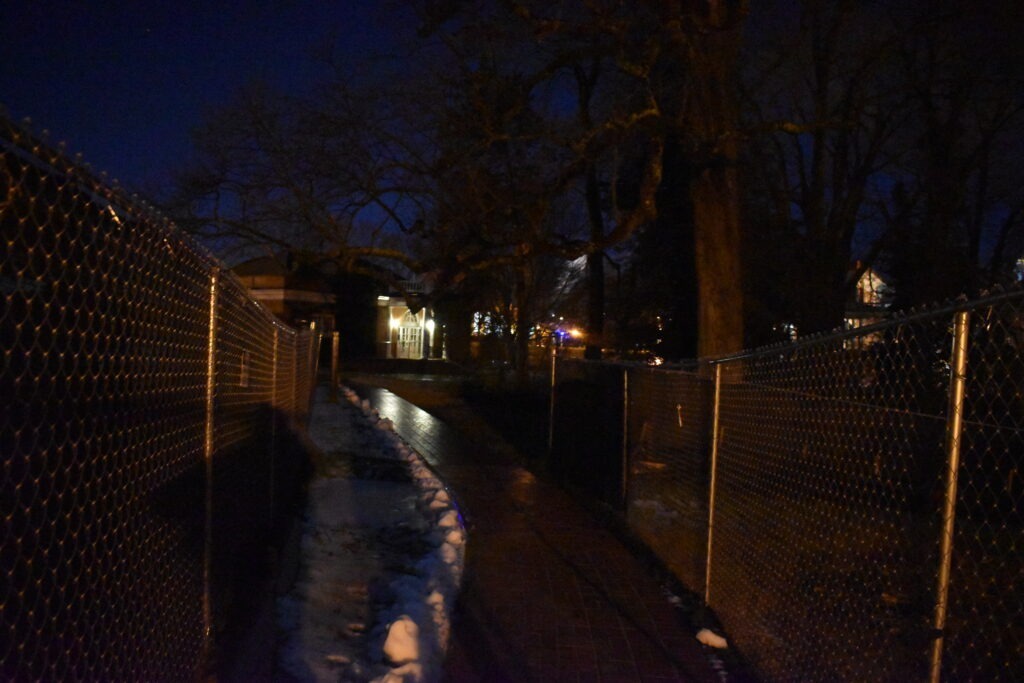LED lights would make campus safer
4 min read
Construction fencing makes already poorly-lit areas, like this path by the Ridderhof Martin Gallery, darker at night.
By ABIGAIL SLAUGHTER
Staff Writer
Campus Walk is too dark.
Even freshman me, who at that time refused to believe that my new school had any shortcomings whatsoever, began to notice on my regular walks to my night class the extremely dim and sometimes ominous lighting along sections of Campus Walk. As fewer students are on campus due to the pandemic, the lighting problem on campus has become even more apparent.
The orange glow from our decades-old lamps have complimented the historic backdrop of our school for many years. However, they are not practical, as they fail to effectively illuminate parts of our campus at night, and a darker campus makes students more vulnerable.
Kevin Cooper, senior communication and digital studies and Spanish double major, has concerns about campus lighting.
“There are just some spots of campus that are completely dark,” said Cooper. Cooper learned that people can sneak up on others on parts of Campus Walk, as he has had friends tell him they did not see him approaching.
In addition to heavily wooded spots beside parts of our brick pathways blocking light, the dark construction fencing lining Seacobeck Hall that blocks light by Virginia Hall creates even more blind spots along Campus Walk. If these well-travelled sections of campus were better lit, students would be safer.
LED lighting would help make campus brighter. According to an article in Private University Products and News Magazine that outlines the benefits of LED lighting on college campuses, these lights reduce shadows and leave fewer dark areas. Although the historic feel of campus created by the orange glow of our current bulbs may be diminished by different lighting, we would still have our academic buildings and residence halls to maintain our campus aesthetic.
Carolyn Fugit, a junior studio art major, feels campus is safe but thinks certain areas of campus could be brighter.
“We definitely need more lighting near Melchers and the Ridderhof Martin Gallery,” said Fugit.
Having fewer students out on Campus Walk means fewer people are around to hold each other accountable to ensure the safety of their fellow students, and this problem is exacerbated by insufficient lighting. Women on campus are still holding their keys between their fingers, walking across a dark campus, now with fewer people around to intervene or report a crime as it happens.
Chief of Police Michael Hall said low numbers on campus presents a huge challenge for campus police.
“That takes away our eyes and ears of the community, whereas when our full community is robust and on campus, our students do a phenomenal job of calling stuff out—they see things,” said Hall.
Campus police have a bigger reach across campus, or what Hall called a bigger “footprint,” when more people are on campus since students consistently report crime. This community policing that UMW students take part in helps to deter crime.
“It takes the community to keep crime at bay,” Hall said.
At the moment, Campus Walk is not as safe as it could be. UMW police have committed to patrolling campus and having minimum staff on duty at all times on top of providing emergency resources for students in danger, but in some ways their hands are tied. They cannot operate the safety escort service due to social distancing guidelines, and the department has faced budget cuts and limited staffing, making it more challenging for the police to protect the community to the best of their ability. As a result, sufficient lighting is more important than ever.
According to a report on factors that influence campus safety, college students are more concerned about their safety outside of university buildings, especially in surrounding areas with insufficient lighting, than their safety inside university buildings. LED lighting would help to counteract our strained police force and make students feel safer.
Facilities Maintenance Services is just as concerned with safety as UMW Police.
“Knowing the importance of outdoor lighting, Facilities makes a concerted effort to respond to outdoor lighting issues within 24-48 hours,” said Facilities Maintenance Services director Nolan Akau.
Maintenance this semester has a tremendous amount of additional responsibility and fewer people than usual to get the work done. This department has been charged with maintaining buildings’ COVID-19 enhancements, from installing COVID signage, to setting up sneeze guards, to keeping over 500 hand sanitizer machines full. As a result, tending to a lighting work order on Campus Walk may not come high up on the priority list to a department charged with so many other tasks. Maintenance carrying this heavy burden of responsibility worries me because lighting, although essential, may not be tended to as quickly.
LED lighting is the solution. LED bulbs’ extreme durability lowers maintenance costs and staff productivity, which would allow Facilities to spend more time focusing on other tasks.


